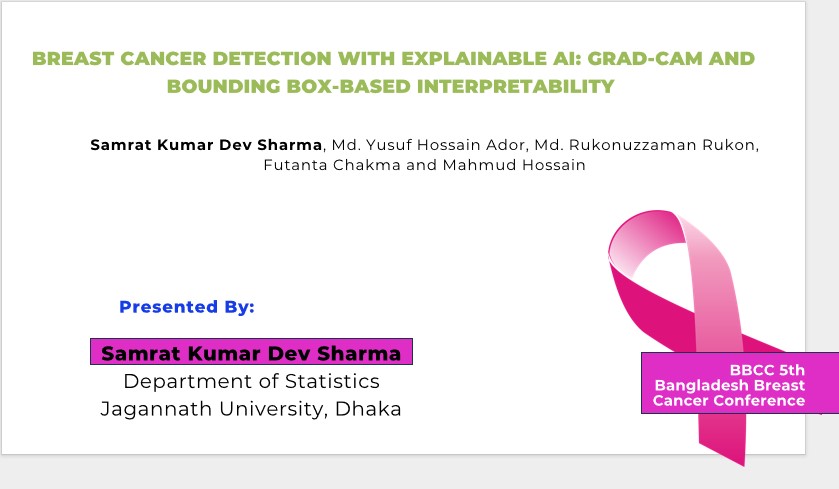Breast Cancer Detection with Explainable AI: Grad-CAM and Bounding Box-Based Interpretability
Authors: Author 1. Samrat Kumar Dev Sharma, BSc student, Department of Statistics, Jagannath University. Dhaka-1100, Bangladesh. Author 2. MD. Yusuf Hossain Ador, MSc student, Department of Statistics, Jagannath University. Dhaka-1100, Bangladesh. Author 3. Rukonozzaman Rukon, MSc student, Department of Statistic, Jagannath University. Dhaka-1100, Bangladesh. Author 4. Mahmud Hossen, BSc student, Department of Statistics, Jagannath University. Dhaka-1100, Bangladesh. Author 5. Futanta Chakma, BSc student
Institution: Jagannath University
Introduction
Breast cancer detection using mammographic images is a crucial application of artificial intelligence (AI) in medical diagnostics. While deep learning models have demonstrated high accuracy, their lack of interpretability hinders clinical adoption. Radiologists require explainable AI (XAI) techniques to ensure AI-generated predictions align with human expertise. This study explores the integration of Grad-CAM heatmaps and bounding box visualization to enhance the transparency and reliability of AI-driven breast cancer detection.
Methods
The dataset, sourced from the RSNA Screening Mammography Breast Cancer Detection competition, includes 54,706 mammographic images in DICOM format with metadata such as laterality, view, age, density rating, and cancer diagnosis. A severe class imbalance (1,158 cancer cases vs. 53,548 non-cancer cases) was addressed using focal loss and an up-sampling factor of 10 for the cancer class. Data augmentation techniques, including random horizontal flips, brightness/contrast adjustments, hue/saturation modifications, coarse dropout, and Mix-up, were applied. ConvNeXtV1-small and EfficientNetV2 architectures were trained, with metadata integrated at the image level. Breast bounding boxes were detected using YOLOX and resized for further processing. Grad-CAM heatmaps were generated to highlight key regions influencing the model’s predictions, and bounding boxes refined lesion localization. Figure 1 illustrates the proposed workflow, showing image preprocessing, model training, and XAI-based interpretability techniques.
Results
The models were evaluated using probabilistic F1 (pF1) scores to assess their effectiveness in detecting breast cancer. Key challenges, such as class imbalance and computational limitations, impacted on the overall performance. Table 1: Presents the pF1 scores achieved by the evaluated models: Model pF1 ConvNeXtV1-small 0.558 EfficientNetV2 0.331 ConvNeXtV1-small demonstrated superior performance with a pF1 score of 0.558, significantly outperforming EfficientNetV2 (0.331). The higher pF1 score suggests that ConvNeXtV1-small is better at extracting meaningful patterns from mammographic images, making it a more reliable choice for breast cancer classification. The application of Grad-CAM heatmaps and bounding boxes provided crucial insights into model predictions. Grad-CAM successfully localized diagnostic features such as masses and calcifications, aligning well with radiologists' assessments. Benign cases often exhibited highlighted dense breast tissue, whereas malignant cases consistently emphasized tumor regions and calcifications. Bounding boxes further refined lesion localization, reducing false positives and helping focus on clinically significant areas. Figure 2 shows representative Grad-CAM heatmaps with bounding boxes, highlighting areas of high model attention. These visualizations demonstrate the effectiveness of XAI techniques in enhancing model interpretability.
Conclusion
This study demonstrates that incorporating Grad-CAM and bounding boxes into AI-based mammography enhances model transparency and aligns with clinical evaluations. These techniques allow radiologists to visually validate AI-driven decisions, improving trust in automated breast cancer detection. The findings underscore the importance of explainable AI (XAI) in medical diagnostics, bridging the gap between deep learning models and radiological practice. Future work will explore Transformer-based architectures and further refinements in data augmentation to enhance model robustness and generalization.
